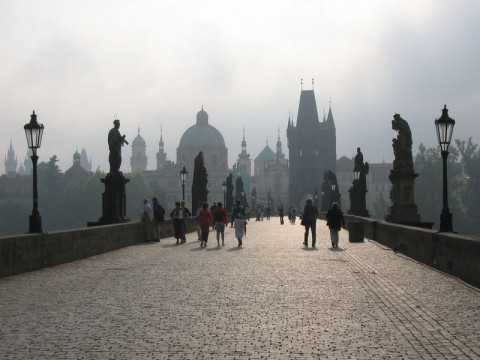
Can you ‘do’ a capital city in 24 hours? No, of course you can’t, not really. But you can enjoy yourself, getting a taste for the place and sharpening your appetite for a return visit.
Landing in Prague and having checked into your hotel and do what any self-respecting Czech would do. Go buy a beer! Sit in a shady spot at one of the many outside tables lots of Prague bars have to make the most of the weather which is a temperate surprise in Prague.
U Flecku is an experience well worth adding to your Prague itinerary. The age of the place (c.1500) is not so evident from the street, but entrance hall soon makes quite an impression! ‘Lobby’ just does not cut it; this place is a warren laid out before your very eyes. The place has so many hidden charms that you just have to go and experience it for yourself, from the concealed courtyard to the salon with its stage for various local entertainments. You’ll be welcomed into the fold and beckoned to one of the many banquets and benches that line the wonderfully medieval hall. Sit back and relax as a heady and delicious liqueur is thrust into your hands. Next, try the house beer, dark and heavy and just as scrumptious.
None of this is free, of course, so watch how gratefully you receive top-ups. It all goes on your bill. But you may not care too much when you find out how delicious the beer is – and how heap! The food is amazing, so there isn’t a bad choice to be made there. Just don’t fall asleep, tired from your journey; in fact, come back again and enjoy this place to the full.
Leaving there, the twilight walk along the riverbank from opposite the Slovansky Ostrov islet to the Zelezninicni railway bridge is a memorable walk. Remember to look back towards the city, with the subtly underlit Charles Bridge and the floodlit castle up above on the hill. With the rest of the town not so well lit, there is a surprising tranquility here in which to view the stars.
Next morning, head up to the castle. It’s a shorter walk than you might think, so take time to dawdle and enjoy being on the bridge and browse the market for jewelry and all manner of crafts. The bridge itself is certainly worthy of note. It was commissioned by Charles IV in the fourteenth century and progressively adorned into the magnificent beast that it now is over the next few centuries.
The Castle isn’t the medieval ruin that you might expect, but was once a fortified walled town. It houses a convent and two churches as well as the magnificent St Vitus cathedral. The place is worthy of a weekend visit all on its own.
On to more historical sites of a more prosaic nature, the Jewish Quarter was an enclosed ghetto hundreds of years before Hitler. In fact, these slums, inhabited since the 16th century, were cleared in the late 19th century, although thankfully for your visit, several synagogues and the cemetery still survive. It might not sound like it, but the cemetery is well worth a visit, but be warned: people queue for this.
On your visit to the Pinkas Synagogue you will be asked to respect the sanctity of the site and men are required to cover their heads (a paper kippah will be supplied, but baseball caps or sunhats are accepted). Inside a hush descends. The foundation dates back to the 15th century. The vaulted central hall, and the later women’s gallery now serve as a memorial to Czech Jews imprisoned in the Terezin camp, from where many were deported to the extermination camps. The walls of the hall and the gallery list the names of those who did not return. The number 77,297 does nothing compared to the sight of the names of the men, women, children written, floor to ceiling on these high walls. The stark reality of that stunned our group to silence. Take the time to visit the small gallery which houses pictures and note books from the children at Terezin, each one accompanied by three dates: birth, transportation to the camp and last known record. The average time of survival in the camp was two years, so there are audible gasps as tourists hit upon the occasional records where a last date is omitted in favor of the word survived’.
Exiting the building into the cemetery itself, proceed around the roped off footpaths, in what was the only burial site for the Jews for three hundred years.
Once you have soaked up the atmosphere and felt some of the incredible weight of history, it’s time to allow yourselves refreshments of warm baguettes and cold beer, then on to the Old Town Square, whose beautiful and diverse architecture documents the development of Prague. You might well find the peace shattered there with the incongruence of a modern music festival, but you’re only here for 24 hours – make the most of it.
Find yourself a quiet restaurant like the ones at the end of the arcaded terrace on the corner of Malostranske Namesti. Many serve traditional Czech food, which you should eat at every opportunity on your short stay in Prague. Tomorrow the plane will come to drag you away. Tonight, relax and soak up local atmosphere, the beer and the food.